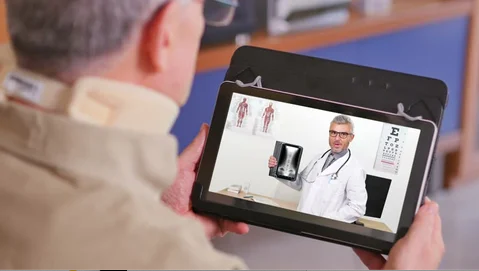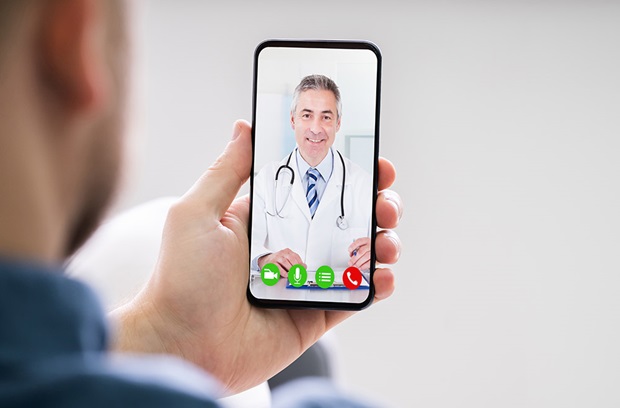Some common pitfalls of telehealth calls… And how to avoid them! Impress your patients and lead the way with top quality remote consultations.
“Doctor, doctor! I feel like a potato!”
From cats on camera, to unwanted Zoom backgrounds, to your kids gatecrashing that one super important meeting, to endless “no you go first”, “no, you go”… By now, we’ve all heard the horror stories about remote working and video conferencing. And oral care is no exception; the concept of telehealth has recently entered into the public psyche in a dramatic way and is heralded by some as the future of healthcare. In fact, telehealth is here to stay for good according to 80% of dentists.
But what is telehealth?
Telehealth is defined by the World Health Organization as the:
“delivery of health care services, where patients and providers are separated by distance. Telehealth uses ICT for the exchange of information for the diagnosis and treatment of diseases and injuries, research and evaluation, and for the continuing education of health professionals.”
(ICT in this definition is: Information and Communication Technology)
Telehealth is not a replacement for an in-person consultation, but it certainly can be an invaluable enhancement for your practice and a simple way to nurture relationships with patients and referral sources during this pandemic.
Expand your practice the easy way
Practicing remote care reduces overhead costs and saves time. If your patient is an elderly person, is sick or high-risk, has a disability, cannot easily leave their home, or has a young family, then distance is no longer a barrier to accessing your top-quality care. Time zones and travel restrictions no longer cause a problem; your surgery can now offer expertise globally. Critically, also, both OMS clinicians and administrators operate in high-risk areas owing to COVID-19, and therefore, telehealth keeps you and your staff safe too.
A telehealth session offers your practice the opportunity to educate and offer reassurance to patients about their conditions, meet and consult with other experts, and walk patients through pre and post-operative care plans.
With the rise of online shopping, at-home entertainment and remote working, everyone expects and enjoys digital experiences as a part of our everyday lives. (Hey, who doesn’t use Amazon, Netflix or video conferencing on the daily?) If your practice is located in a smaller building, then take advantage of offering a virtual appointment, and the opportunity for some staff to work from home, saving you valuable office space. Telehealth is a fantastic way of expanding your surgery, whilst conserving resources, time, energy, money and space.
However, if you’re new to this technology, telehealth can seem daunting. Here are some common pitfalls and how you can avoid them, so you can hold the best virtual consultations your patient could ever hope for.
Get your marketing game on
Prepare current and returning patients for your telehealth services during a face-to-face appointment. Some patients and healthcare professionals are still sceptical about telehealth, and so in-person encouragement is the best way of reassuring them, and answering any questions they may have. Alternatively, send out video demos in emails or SMS that demonstrate a telehealth session and explain the benefits of this technology. A personal phone call is also a high-touch way of communicating your telehealth services to healthcare professionals, and patients alike.
For those who are new to your surgery, put out as much free, educational, digital content as you can. This will add value to your services. Both patients and healthcare professionals will be attracted to surgeries that are generous with their innovative knowledge and are open to communication and questions.
Make dentists and general practitioners aware that this is a digital service you are now offering so that they can advise and refer their patients accordingly. Through telehealth, your surgery suddenly may not seem so far away, and patients right across the world can be referred to your practice.
Booking made simple
Digital sessions can slip the mind more easily than in-person appointments, and it is, therefore, important to remind patients about their consultation regularly. Be sure to include an ‘add to calendar’ button to emails where possible, so that the patients can be reminded by their diaries as well. Signpost the access link to the session clearly so that it is straightforward for your patient to follow, and do make sure your telehealth software is HIPAA compliant. Make things simple for the patient, and use software that allows one-click access. Patients love a high-tech, virtual experience that is smooth and no-fuss.
Use safe technology
Patient data is very private and highly vulnerable. Whilst some OMS administrators may believe that their practices will not be targeted by cyberattacks, no one should get complacent. Every OMS surgery will be heavily reliant on data stored on electronic devices and is therefore at risk. On a telehealth call, you may be sharing and sending vulnerable data, or you may be exposed to ‘Zoom-bombers’ or similar video call hackers. A breach like this could open your practice to liability. Got you feeling just a little bit queasy? Well, have no fear, the good news is you don’t need to be a computer geek to protect your practice from threat.
End-to-end encryption ensures that only your device and the patient’s device will be able to decipher the data being sent. Make sure that the video call software you are using has end-to-end encryption, and that you regularly update your software in order to defend you and your patients’ data from third parties, cyber threat, hackers and computer viruses. There are multiple cybersecurity firms out there that will help you protect your devices from cyber attack, and these may be worth investing in to give your patients total peace of mind. Patients will be aware of headline news stories of data breaches, so why not reassure them that their data is absolutely safe by using updated, secure virtual consulting platforms?
Video conferencing done the right way
Video conferencing fatigue is a thing right now. For. Sure. So focusing during a call could be a challenge for some of your patients. Once you have welcomed them into your virtual consultation room, remove any distractions that might be unhelpful for the patient. There are loads of great programs and plug-ins that minimize onscreen distractions for patients and allow you to see the patient clearly on your screen at all times, whilst also giving you the ability to share your screen with them.
Eye contact is crucial to in-person communication, but on a screen, too much intense eye contact could cause your patient to feel under surveillance. Some people report feeling the same stress communicating over video conferencing as public speaking! Looking down to check notes, for example, can offer a pause in eye contact whilst still being attentive. Also be sure to listen well to your patient. It might sound simple, but nods and smiles encourage the patient to be more open with you.
Using props, animations, diagrams, infographs, and presentations are all good ways to engage with and educate a patient.
Invest in a good ‘on-screen’ set up. It is much easier for a patient to engage with you when you are well-lit, have a good mic and a tidy background.

Improve your practice!
Surveys are a great way of gaining insight from a patient’s perspective. It is particularly important to gather patient testimonies about any new technology or practice that your surgery is implementing. Encourage your patient to fill in the survey towards the end of your video call with them (just remember to reassure your patient that their survey responses will be secure and protected).
The benefits of telehealth are endless. Telehealth may be the future of OMS surgeries. It’s vital to make it work for you now and stay ahead of the virtual healthcare boom. Look for opportunities to improve your telehealth consultation services and provide a better patient experience.
So, how do you feel about telehealth? Is it the future of OMS care? Share your stories with us!

